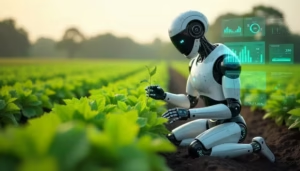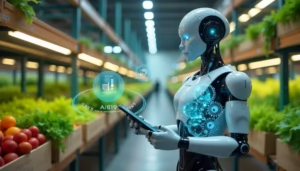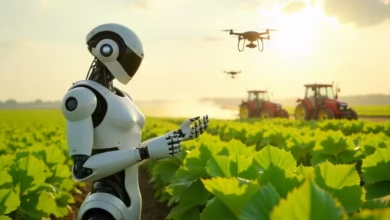AI in Agriculture: Feeding the World with Precision Technology

The blog post explores the transformative role of AI in agriculture, highlighting how this technology is a game changer for farmers. It discusses innovative smart farming techniques that enhance crop prediction, enabling more precise planting and harvesting strategies. Additionally, AI is revolutionizing agricultural supply chains, optimizing processes from production to distribution, thereby reducing waste and improving efficiency. The article also outlines actionable steps for integrating AI in agriculture, providing farmers with practical guidance on adopting these advanced technologies to boost productivity and sustainability. As the global population continues to grow, leveraging AI in agriculture will be essential in meeting food demands while ensuring environmental stewardship.
Understanding AI In Agriculture: A Game Changer For Farmers

AI in agriculture is revolutionizing traditional farming practices by introducing innovative technologies that enhance productivity and sustainability. Farmers are increasingly adopting these systems to leverage data-driven insights, leading to better crop management and increased efficiency. This shift towards smart farming enables growers to monitor conditions in real-time, predicting outcomes and responding proactively to challenges. By utilizing AI tools, farmers can optimize input use and minimize waste, ultimately improving their power of decision-making.
Key Benefits Of AI In Agriculture
- Enhanced Crop Monitoring: AI technologies provide real-time data on crop health and soil conditions.
- Precision Farming: Allows for targeted application of resources, reducing costs and environmental impact.
- Predictive Analytics: Enables farmers to forecast weather patterns and yield potential, resulting in better planning.
- Resource Optimization: Improves the efficiency of irrigation and fertilization practices.
- Pest and Disease Management: AI tools assist in early detection and treatment of crop issues.
- Automated Labor Solutions: Robotics and AI-powered machinery reduce manual labor needs.
- Data Insights: Provides actionable information, allowing for informed decision-making.
As farmers embrace AI in agriculture, they experience a significant transformation in how they manage their farms. The integration of smart technologies simplifies complex processes and promotes sustainability, ensuring that agricultural practices can meet the demands of a growing population. Furthermore, these advancements empower farmers to make better choices regarding crop selection and resource allocation, contributing to a more resilient food system overall.
Exploring Smart Farming Techniques That Transform Crop Prediction

Smart farming techniques are rapidly evolving, leveraging the latest advancements in technology, including AI in agriculture. By harnessing data-driven insights, farmers can significantly enhance their crop prediction capabilities. This not only ensures higher yields but also optimizes resource allocation, ultimately leading to a more sustainable agricultural practice. With the rise of precision technology, agricultural robots are playing a pivotal role in streamlining various farming processes, thus transforming traditional methods of crop cultivation.
| Technology | Application | Benefits |
|---|---|---|
| Drones | Crop monitoring and soil analysis | Enhanced data accuracy and time-efficiency |
| IoT Sensors | Real-time data collection on soil and climate conditions | Informed decision-making |
| Machine Learning Algorithms | Predictive analytics for crop yields | Improved forecasting accuracy |
| Autonomous Tractors | Automated planting and harvesting | Reduced labor costs and increased efficiency |
The integration of advanced technologies equips farmers with tools to analyze vast amounts of data. These insights allow for accurate crop prediction, enabling farmers to make informed decisions about planting times, irrigation needs, and pest control measures. As agricultural robots continue to advance, their ability to perform tasks such as seed planting and weed control will reduce the workload for farmers, allowing them to focus on strategic planning and management practices.
Steps To Implement Smart Farming
- Assess current farming needs and identify areas for improvement.
- Research available smart farming technologies suitable for your farm.
- Develop a data collection system to gather essential information.
- Invest in training for staff on new technologies and methodologies.
- Integrate IoT devices and AI applications for enhanced data analysis.
- Monitor the impact of new techniques on crop prediction and yields.
- Continuously adapt and evolve strategies based on data insights and emerging technologies.
In conclusion, the combination of AI in agriculture with smart farming techniques is revolutionizing how crop prediction is approached. Through effective data collection and technology integration, farmers are empowered to make better decisions leading to increased productivity and sustainability in the agriculture sector.
Data Collection Methods
Effective data collection is the backbone of precision agriculture. Employing methods such as soil sampling, satellite imagery, and real-time sensor data allows farmers to obtain comprehensive insights on crop health and soil conditions. This data not only aids in accurate crop prediction but also helps in fine-tuning practices such as irrigation and fertilization to ensure optimal growth.
Technology Integration Strategies
Integrating modern technology into agricultural practices requires careful planning and execution. By establishing clear goals and engaging in thorough training, farmers can seamlessly adopt agricultural robots and AI tools. These technologies must be woven into the existing workflow to maximize their potential, ultimately leading to improved efficiency and productivity in farming operations.
AI Food Systems: Revolutionizing The Agriculture Supply Chain

The integration of AI in agriculture is not merely a trend; it is a transformative force that is reshaping the agricultural landscape. By utilizing data-driven technologies, farmers are now able to enhance their productivity and sustainability. This shift is prominently highlighted through the emergence of AI food systems, which streamline supply chains from production to distribution. These systems help in making informed decisions, thereby reducing waste, optimizing resources, and ultimately contributing to global food security.
Among the innovations at the forefront of these advancements are agricultural robots. Equipped with AI algorithms, these robots perform tasks that range from planting and harvesting to pest control and crop monitoring. Their ability to operate efficiently in various conditions allows farmers to maximize yields and minimize labor costs. Furthermore, these robots can be programmed to adapt in real-time, making them invaluable assets in dynamic agricultural environments.
Key Components Of AI Food Systems
- Data Analytics: Utilizes algorithms to process large datasets for predicting trends and outcomes.
- Machine Learning: Allows systems to learn from data over time and improve efficiencies.
- Robotics: Incorporates physical machines for automated tasks in farming.
- IoT Sensors: Collects real-time data regarding soil health, climate conditions, and crops.
- Supply Chain Integration: Streamlines the connection between producers and consumers for better distribution.
- Agricultural Drones: Provides aerial imagery and data on crop health and growth patterns.
The impact of AI food systems reaches beyond mere productivity; it also fosters sustainable practices. By leveraging predictive analytics, farmers can optimize water usage and reduce reliance on harmful pesticides. This technological transition not only leads to improved yield but also enhances the environmental stewardship of agricultural operations. As these systems advance, they will continue to redefine the methods by which food is produced, processed, and delivered.
Examples Of AI Food Systems
Examples of successful AI food systems are emerging worldwide, showcasing how technology is enhancing agricultural practices. In various regions, farms equipped with precision farming tools are witnessing significant boosts in efficiency. Companies are developing platforms that integrate AI with farming equipment to enable precise planting and automated irrigation systems. Moreover, collaborative initiatives between technology firms and research institutions are fostering innovative strategies to overcome challenges faced in agriculture, indicating a future where food production is even more closely aligned with AI advancements.
Actionable Steps For Integrating AI In Agriculture

Integrating AI in agriculture is essential for achieving remarkable efficiency and precision in farming practices. To truly harness the potential of smart farming technologies, farmers must adopt a structured approach. This means embracing innovative solutions that not only improve crop yields but also offer advanced crop prediction capabilities. As the agricultural sector faces numerous challenges, from climate change to increasing food demand, the need for a tech-driven transition is more crucial than ever.
Steps To Begin Using AI In Agriculture
- Assess current farming practices to identify areas that could benefit from AI interventions.
- Research various AI tools and software specifically designed for agricultural applications.
- Implement remote sensing technology to gather real-time data on soil, weather, and crop health.
- Utilize machine learning algorithms for improved crop prediction and decision-making processes.
- Establish partnerships with tech companies and agricultural experts to guide implementation.
- Train staff on new technologies to ensure smooth integration of AI into daily operations.
- Continuously monitor and evaluate AI-driven initiatives for ongoing refinement and improvement.
By following these actionable steps, farmers can effectively transform their operations through smart farming methods. Embracing trends in AI-powered solutions positions agricultural businesses for success in a competitive landscape, ultimately enabling them to meet the growing food demands worldwide.
Briefing Document
AI in Agriculture: Feeding the World with Precision Technology
I. Executive Summary
This briefing document summarizes the transformative role of Artificial Intelligence (AI) in agriculture, as outlined in “AI in Agriculture: Feeding the World with Precision Technology – The Future of Artificial Intelligence.” AI is presented as a “game changer for farmers,” revolutionizing traditional practices through data-driven insights, smart farming techniques, and optimized supply chains. The core message emphasizes AI’s critical role in meeting global food demands while ensuring environmental stewardship. Key benefits include enhanced crop monitoring, precision farming, predictive analytics, resource optimization, pest/disease management, automated labor solutions, and improved data insights for decision-making.
II. Main Themes and Key Ideas
A. AI as a Game Changer for Farmers
AI in agriculture is fundamentally reshaping farming by introducing innovative technologies that boost productivity and sustainability. The shift towards “smart farming” empowers growers with real-time monitoring and predictive capabilities, enabling proactive responses to challenges. By leveraging AI tools, farmers can “optimize input use and minimize waste, ultimately improving their power of decision-making.”
Key Benefits of AI in Agriculture:
- Enhanced Crop Monitoring: Provides “real-time data on crop health and soil conditions.”
- Precision Farming: Enables “targeted application of resources, reducing costs and environmental impact.”
- Predictive Analytics: Allows farmers to “forecast weather patterns and yield potential, resulting in better planning.”
- Resource Optimization: Improves “the efficiency of irrigation and fertilization practices.”
- Pest and Disease Management: AI tools “assist in early detection and treatment of crop issues.”
- Automated Labor Solutions: “Robotics and AI-powered machinery reduce manual labor needs.”
- Data Insights: “Provides actionable information, allowing for informed decision-making.”
The integration of smart technologies simplifies complex processes, promotes sustainability, and ensures agricultural practices can meet the demands of a growing population.
B. Smart Farming Techniques and Crop Prediction
Smart farming leverages AI to significantly enhance crop prediction capabilities, leading to higher yields and optimized resource allocation for sustainable agricultural practices. Precision technology, including agricultural robots, plays a pivotal role in streamlining farming processes.
Technology Applications and Benefits:
- Drones: For “Crop monitoring and soil analysis,” offering “Enhanced data accuracy and time-efficiency.”
- IoT Sensors: For “Real-time data collection on soil and climate conditions,” leading to “Informed decision-making.”
- Machine Learning Algorithms: For “Predictive analytics for crop yields,” resulting in “Improved forecasting accuracy.”
- Autonomous Tractors: For “Automated planting and harvesting,” leading to “Reduced labor costs and increased efficiency.”
These technologies provide farmers with tools to analyze vast amounts of data, enabling accurate “crop prediction” and informed decisions on planting times, irrigation, and pest control. Agricultural robots reduce workload, allowing farmers to focus on strategic planning.
Data Collection Methods: Effective data collection is the “backbone of precision agriculture,” involving “soil sampling, satellite imagery, and real-time sensor data” to obtain comprehensive insights for crop health and soil conditions. This data aids in accurate “crop prediction” and fine-tuning practices like irrigation and fertilization.
C. AI Food Systems: Revolutionizing the Agriculture Supply Chain
AI integration is a “transformative force reshaping the agricultural landscape” by streamlining supply chains from production to distribution. “AI food systems” make informed decisions, “thereby reducing waste, optimizing resources, and ultimately contributing to global food security.”
Key Components of AI Food Systems:
- Data Analytics: “Utilizes algorithms to process large datasets for predicting trends and outcomes.”
- Machine Learning: “Allows systems to learn from data over time and improve efficiencies.”
- Robotics: “Incorporates physical machines for automated tasks in farming.”
- IoT Sensors: “Collects real-time data regarding soil health, climate conditions, and crops.”
- Supply Chain Integration: “Streamlines the connection between producers and consumers for better distribution.”
- Agricultural Drones: “Provides aerial imagery and data on crop health and growth patterns.”
Agricultural robots, equipped with AI algorithms, perform tasks from planting and harvesting to pest control and crop monitoring, operating efficiently in various conditions to maximize yields and minimize labor costs. AI food systems also foster sustainable practices by leveraging predictive analytics to optimize water usage and reduce reliance on harmful pesticides, enhancing “environmental stewardship.”
D. Actionable Steps for Integrating AI in Agriculture
Integrating AI in agriculture requires a structured approach to achieve “remarkable efficiency and precision.” This transition is crucial given challenges like climate change and increasing food demand.
Steps to Begin Using AI in Agriculture:
- Assess current farming practices: Identify areas benefiting from AI.
- Research AI tools and software: Specifically designed for agriculture.
- Implement remote sensing technology: To gather real-time data.
- Utilize machine learning algorithms: For improved “crop prediction” and decision-making.
- Establish partnerships: With tech companies and agricultural experts.
- Train staff: To ensure smooth integration of AI.
- Continuously monitor and evaluate: AI-driven initiatives for refinement.
By following these steps, farmers can transform operations through smart farming, positioning their businesses for success and meeting global food demands.
The document underscores that AI is not just a trend but an essential technology for the future of agriculture. It offers concrete benefits in enhancing productivity, sustainability, and efficiency across the entire food supply chain. The practical guidance provided on implementing AI demonstrates a clear path for farmers to adopt these advanced technologies, ensuring food security and environmental responsibility for a growing global population.
Artificial intelligence / humanaifuture.com
🎧 Listen to the Podcast
Want to explore this topic in more depth? Listen to the full podcast for more insights and expert commentary.
▶️ Play on Google DriveNo sign-up needed — just click and listen.
How does AI enhance crop monitoring and prediction?
AI significantly enhances crop monitoring and prediction through real-time data collection and advanced analytics. Technologies like drones provide aerial imagery and data on crop health, while IoT sensors collect information on soil and climate conditions. Machine learning algorithms then process this vast amount of data to offer predictive analytics for crop yields, weather patterns, and early detection of pests and diseases. This enables farmers to make informed decisions about planting times, irrigation, and pest control, leading to higher yields and optimized resource allocation.
What are "smart farming techniques" and how do they leverage AI?
Smart farming techniques are modern agricultural methods that utilize advanced technologies, including AI, to improve efficiency and sustainability. These techniques involve the use of drones for monitoring, IoT sensors for data collection, machine learning algorithms for predictive analytics, and autonomous tractors for automated tasks. By integrating these technologies, smart farming empowers farmers with data-driven insights to make precise decisions, reducing manual labor, optimizing resource use, and transforming traditional crop cultivation practices.
How do AI food systems revolutionize the agricultural supply chain?
AI food systems are revolutionizing the agricultural supply chain by streamlining processes from production to distribution. These systems utilize data analytics, machine learning, robotics, and IoT sensors to make informed decisions, which helps in reducing waste, optimizing resource allocation, and ensuring global food security. By integrating these components, AI food systems create a more efficient and responsive supply chain, connecting producers and consumers more effectively.
What role do agricultural robots play in modern farming?
Agricultural robots play a pivotal role in modern farming by automating a wide range of tasks, thereby streamlining various farming processes and reducing manual labor needs. Equipped with AI algorithms, these robots can perform precise tasks such as planting, harvesting, pest control, and crop monitoring. Their ability to operate efficiently in diverse conditions, adapt in real-time, and maximize yields while minimizing labor costs makes them invaluable assets in dynamic agricultural environments.
What are the key benefits of integrating AI in agriculture?
The integration of AI in agriculture offers numerous key benefits. These include enhanced crop monitoring through real-time data, precision farming for targeted resource application, predictive analytics for better planning, and optimized resource utilization for irrigation and fertilization. Additionally, AI assists in early detection and management of pests and diseases, provides automated labor solutions through robotics, and offers valuable data insights for informed decision-making, all contributing to increased productivity and sustainability.
What actionable steps can farmers take to integrate AI into their operations?
Farmers can take several actionable steps to integrate AI into their operations. These include:
- Assessing current needs: Identify areas where AI interventions can provide the most benefit.
- Researching AI tools: Explore various AI tools and software designed for agricultural applications.
- Implementing remote sensing: Gather real-time data on soil, weather, and crop health.
- Utilizing machine learning: Employ algorithms for improved crop prediction and decision-making.
- Forming partnerships: Collaborate with tech companies and agricultural experts.
- Training staff: Ensure smooth integration of new technologies into daily operations.
- Continuous monitoring: Evaluate AI-driven initiatives for ongoing refinement and improvement.
Following these steps allows farmers to effectively transform their operations through smart farming methods.
How does AI contribute to agricultural sustainability and global food security?
AI significantly contributes to agricultural sustainability and global food security by optimizing resource use and enhancing efficiency. Through predictive analytics, farmers can optimize water usage, reduce reliance on harmful pesticides, and minimize waste across the supply chain. The ability of AI to improve crop yields, facilitate precision farming, and streamline distribution processes ensures that agricultural practices can meet the demands of a growing global population more sustainably. This technological transition leads to improved environmental stewardship and a more resilient food system overall.




